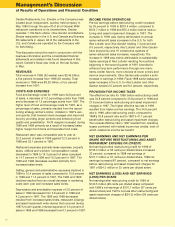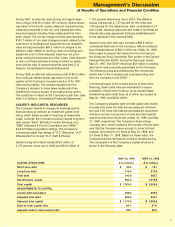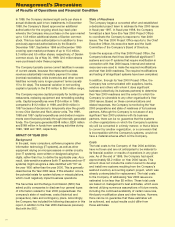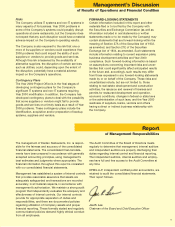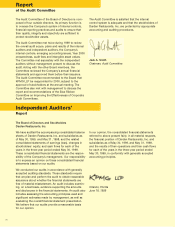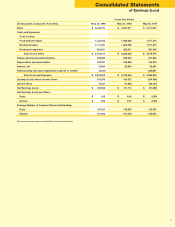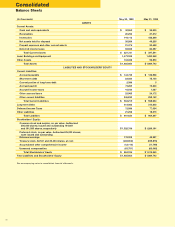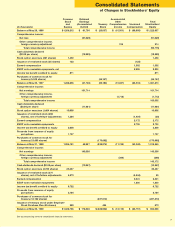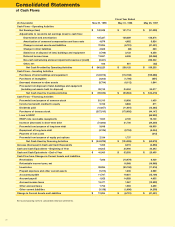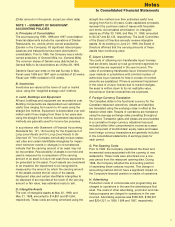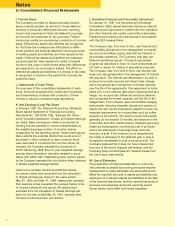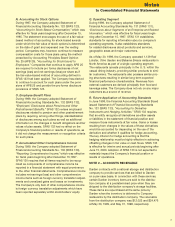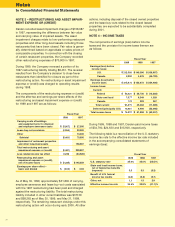Red Lobster 1999 Annual Report Download - page 3
Download and view the complete annual report
Please find page 3 of the 1999 Red Lobster annual report below. You can navigate through the pages in the report by either clicking on the pages listed below, or by using the keyword search tool below to find specific information within the annual report.
Management’s Discussion
of Results of Operations and Financial Condition
24
In 1999, the Company declared eight cents per share in
annual dividends paid in two installments. In December
1998, the Company’s Board approved an additional
authorization for the ongoing stock buy-back plan
whereby the Company may purchase on the open market
up to 13.8 million additional shares of Darden common
stock. This buy-back authorization is in addition to three
previously approved authorizations by the Board in
December 1997, September 1996 and December 1995
covering open market purchases of up to 15.0 million,
9.3 million and 6.5 million shares, respectively, of Darden
common stock. As of May 30, 1999, 32.6 million shares
were purchased under these programs.
The Company typically carries current liabilities in excess
of current assets, because the restaurant business
receives substantially immediate payment for sales
(nominal receivables), while inventories and other current
liabilities normally carry longer payment terms (usually
15 to 30 days). The seasonal variation in net working
capital is typically in the $10 million to $50 million range.
The Company requires capital principally for building new
restaurants, replacing equipment and remodeling existing
units. Capital expenditures were $124 million in 1999,
compared to $112 million in 1998, and $160 million in
1997 because of decisions to temporarily slow the growth
in new Olive Garden and Red Lobster units. The 1999,
1998 and 1997 capital expenditures and dividend require-
ments were financed primarily through internally generated
funds. The Company generated $348 million, $236 million
and $189 million in funds from operating activities during
1999, 1998 and 1997, respectively.
IMPACT OF YEAR 2000
Background
In the past, many computers, software programs other
information technology (IT systems), as well as other
equipment relying on microprocessors or similar circuitry
(non-IT systems), were written or designed using two
digits, rather than four, to define the applicable year. As a
result, date-sensitive systems (both IT systems and non-IT
systems) might recognize a date identified with “00” as
the year 1900 rather than the year 2000. This is generally
described as the Year 2000 issue. If this situation occurs,
the potential exists for system failures or miscalculations,
which could negatively impact business operations.
The Securities and Exchange Commission (SEC) has
asked public companies to disclose four general types
of information related to Year 2000 preparedness: the
company’s state of readiness, costs (historical and
prospective), risks and contingency plans. Accordingly,
the Company has included the following discussion in this
report, in addition to the Year 2000 disclosures previously
filed with the SEC.
State of Readiness
The Company began a concerted effort and established
a dedicated project team to address its Year 2000 issues
in fiscal year 1997. In fiscal year 1998, the Company
formalized a task force (the Year 2000 Project Office)
to coordinate the Company’s response to Year 2000
issues. The Year 2000 Project Office reports to the Chief
Executive Officer, his executive team and the Audit
Committee of the Company’s Board of Directors.
Under the auspices of the Year 2000 Project Office, the
Company believes that it has identified all significant IT
systems and non-IT systems that require modification in
connection with Year 2000 issues. Internal and external
resources were used to make the required modifications
and test Year 2000 readiness. The required modifications
and testing of all significant systems have been completed.
In addition, through its Year 2000 Project Office, the
Company has communicated with suppliers, banks,
vendors and others with whom it does significant
business (collectively, its business partners) to determine
their Year 2000 readiness and the extent to which the
Company is vulnerable to any other organization’s Year
2000 issues. Based on these communications and
related responses, the Company is monitoring the Year
2000 preparations and state of readiness of its business
partners. Although the Company is not aware of any
significant Year 2000 problems with its business
partners, there can be no guarantee that the systems
of other organizations on which the Company’s systems
rely will be converted in a timely manner, or that a failure
to convert by another organization, or a conversion that
is incompatible with the Company’s systems, would not
have a material adverse effect on the Company.
Costs
The total costs to the Company of Year 2000 activities
have not been and are not anticipated to be material to
its financial position or results of operations in any given
year. As of the end of 1999, the Company had spent
approximately $3.2 million on Year 2000 issues. This
amount does not include the costs incurred to develop
and install new systems resulting from the Company’s
seafood inventory accounting system project, which was
already contemplated for replacement. The total costs
to the Company of addressing Year 2000 issues are
estimated to be less than $5 million. These total costs
are based on management’s best estimates, which were
derived utilizing numerous assumptions of future events,
including the continued availability of certain resources,
third-party modification plans and other factors. However,
there can be no guarantee that these estimates will
be achieved, and actual results could differ from
those estimates.

